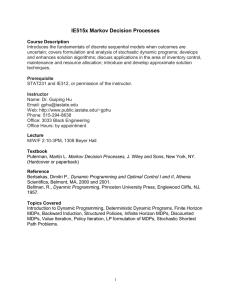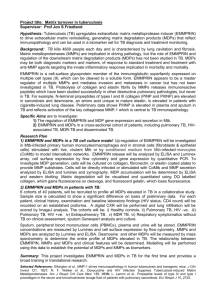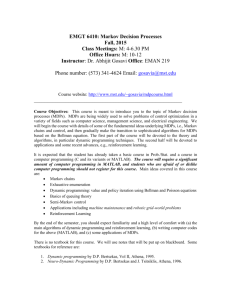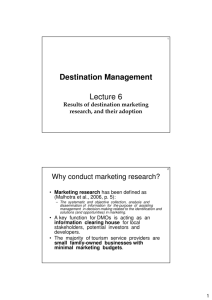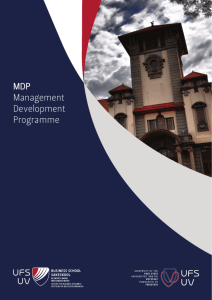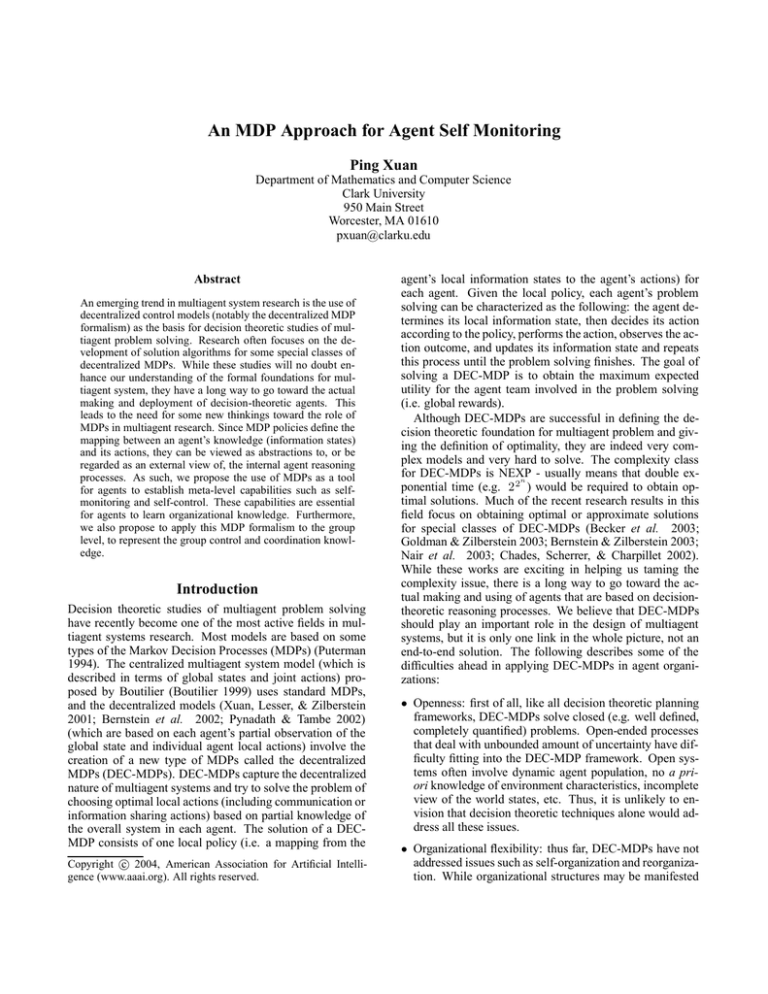
An MDP Approach for Agent Self Monitoring
Ping Xuan
Department of Mathematics and Computer Science
Clark University
950 Main Street
Worcester, MA 01610
pxuan@clarku.edu
Abstract
An emerging trend in multiagent system research is the use of
decentralized control models (notably the decentralized MDP
formalism) as the basis for decision theoretic studies of multiagent problem solving. Research often focuses on the development of solution algorithms for some special classes of
decentralized MDPs. While these studies will no doubt enhance our understanding of the formal foundations for multiagent system, they have a long way to go toward the actual
making and deployment of decision-theoretic agents. This
leads to the need for some new thinkings toward the role of
MDPs in multiagent research. Since MDP policies define the
mapping between an agent’s knowledge (information states)
and its actions, they can be viewed as abstractions to, or be
regarded as an external view of, the internal agent reasoning
processes. As such, we propose the use of MDPs as a tool
for agents to establish meta-level capabilities such as selfmonitoring and self-control. These capabilities are essential
for agents to learn organizational knowledge. Furthermore,
we also propose to apply this MDP formalism to the group
level, to represent the group control and coordination knowledge.
Introduction
Decision theoretic studies of multiagent problem solving
have recently become one of the most active fields in multiagent systems research. Most models are based on some
types of the Markov Decision Processes (MDPs) (Puterman
1994). The centralized multiagent system model (which is
described in terms of global states and joint actions) proposed by Boutilier (Boutilier 1999) uses standard MDPs,
and the decentralized models (Xuan, Lesser, & Zilberstein
2001; Bernstein et al. 2002; Pynadath & Tambe 2002)
(which are based on each agent’s partial observation of the
global state and individual agent local actions) involve the
creation of a new type of MDPs called the decentralized
MDPs (DEC-MDPs). DEC-MDPs capture the decentralized
nature of multiagent systems and try to solve the problem of
choosing optimal local actions (including communication or
information sharing actions) based on partial knowledge of
the overall system in each agent. The solution of a DECMDP consists of one local policy (i.e. a mapping from the
c 2004, American Association for Artificial IntelliCopyright gence (www.aaai.org). All rights reserved.
agent’s local information states to the agent’s actions) for
each agent. Given the local policy, each agent’s problem
solving can be characterized as the following: the agent determines its local information state, then decides its action
according to the policy, performs the action, observes the action outcome, and updates its information state and repeats
this process until the problem solving finishes. The goal of
solving a DEC-MDP is to obtain the maximum expected
utility for the agent team involved in the problem solving
(i.e. global rewards).
Although DEC-MDPs are successful in defining the decision theoretic foundation for multiagent problem and giving the definition of optimality, they are indeed very complex models and very hard to solve. The complexity class
for DEC-MDPs is NEXP
- usually means that double exn
ponential time (e.g. 2 2 ) would be required to obtain optimal solutions. Much of the recent research results in this
field focus on obtaining optimal or approximate solutions
for special classes of DEC-MDPs (Becker et al. 2003;
Goldman & Zilberstein 2003; Bernstein & Zilberstein 2003;
Nair et al. 2003; Chades, Scherrer, & Charpillet 2002).
While these works are exciting in helping us taming the
complexity issue, there is a long way to go toward the actual making and using of agents that are based on decisiontheoretic reasoning processes. We believe that DEC-MDPs
should play an important role in the design of multiagent
systems, but it is only one link in the whole picture, not an
end-to-end solution. The following describes some of the
difficulties ahead in applying DEC-MDPs in agent organizations:
• Openness: first of all, like all decision theoretic planning
frameworks, DEC-MDPs solve closed (e.g. well defined,
completely quantified) problems. Open-ended processes
that deal with unbounded amount of uncertainty have difficulty fitting into the DEC-MDP framework. Open systems often involve dynamic agent population, no a priori knowledge of environment characteristics, incomplete
view of the world states, etc. Thus, it is unlikely to envision that decision theoretic techniques alone would address all these issues.
• Organizational flexibility: thus far, DEC-MDPs have not
addressed issues such as self-organization and reorganization. While organizational structures may be manifested
in DEC-MDP policies (for example, some agents are allocated more tasks and more tightly coupled than some
others), there is no group awareness or group representation.
• Stability: like typical MDPs, the optimal solution for
DEC-MDPs is very sensitive to slight changes in the environment. This may present problem for organizational
stability. So far, DEC-MDPs are used to to model one
episode of problem solving, but agents organizations are
meant for long term collaborations. In these cases, there
may not be clear notion of the start or finish of problem
solving.
• Structured problem solving: MDP policies are very low
level representations of plans. The plan is exhaustive in
detail and has only one flat level. The lack of structure for
clearly reflecting task flows and task hierarchies makes
the representation rather unappealing and also very hard
to scale.
• Complexity and overheads: although in theory an agent
only needs its local policy to carry out the problem solving (in a rather mechanical way), there is the question
of how to obtain such a policy. Requiring each agent to
independently compute the identical policy is obviously
impractical and wasteful. Offline or centralized computation may be a possibility, but that would mean that the
agents receiving their local policies really have very little
control (or intelligence). In DEC-MDPs, the local policy
alone does not enable one agent to reason about its role in
the team work, since the reward structure is defined over
global states and therefore to calculate the reward we need
to know the local policies in all agents, not just one.
These difficulties lead us to explore the means of integrating decision theoretic approaches in agent organizations.
We notice that one interesting difference between the MDP
approach and other traditional multiagent planning frameworks is that the MDP policies do not talk about the agent’s
goals, intentions, desires, etc – these are really high metalevel constructs that reflect the agent’s internal reasoning
process. In fact, an MDP policy need not to have the notion
of agent internal reasoning process at all - all is involved is
one lookup. There is no direct or obvious line of reasoning
to justify or interpret the agent action other than the simple
belief that the policy is working toward a maximum (or close
to optimal) expected global reward – for MDPs, those interpretations or internal reasoning processes are not important
any more because the policy already completely defines the
agent’s behavior. In other words, the policy is the agent.
Generally, if an agent’s policy is known to others, then the
agent’s behavior is predictable given the information state
of the agent. As such, other agents will not be interested in
the internal reasoning process employed in this agent. Conversely, if the agent can reveal information about the policy
it uses, it does not need to reveal details of its internal reasoning process. This is very important in open multiagent
systems because a truly open system must allow cooperation among heterogeneous agents. Here, the heterogeneity
not only refers to the difference in the agents’ capabilities,
resources, and roles, but also is manifested in the different
internal reasoning techniques and processes that agents use.
Because MDPs are neutral to the different types of reasoning models, they can be used as a common representation
for agents to reason about other agents’ behaviors without
the knowledge about other agents’ internal reason process.
However, this does not mean that the agents should post
their MDPs and policies to each other (hence converting to
decision-theoretic agents in effect) – that would be rather
cumbersome as discussed above. Instead, we want to use
MDPs to provide a level of abstraction for the agent’s internal reasoning process, try to preserve the meta-level representation of the agent plans. If we can use MDPs to provide
an encapsulated view of the agent plan, then this view can
serve not only as a yardstick for self-monitoring, but also
as the interface for other agents to understand its behavior.
The key here is to use MDPs to represent the plan dynamics
without tying to the process of making plans or the detailed
plan (policy) itself. The evolution of a plan can be modeled
in a stochastic process, and the meta level decisions made
toward the plan can be regarded as a decision process. An
MDP model that provides these information would be the
first step toward the establishment of self-awareness in agent
problem solving.
In this paper, we first provide a mechanism that uses MDP
formalisms to encapsulate agent behavior, show how we can
use it for agent self-monitoring and self control, and then
extend it to the group level to represent coordination knowledge and provide a tool for group level monitoring.
Agent Policy Abstractions
Our first step toward establishing a formalism for the agent
plan dynamics is to establish abstract views of agent plans.
This does not mean that we want to translate the agent plan
into an MDP policy, although this is possible in most cases.
Instead, we want to focus on meta-level views of the agent
plan. In the following we first discuss the general approach,
and then discuss a detailed example in the context of systems
using traditional multiagent planning techniques.
Typically, a plan tries to achieve a certain goal. In the
most trivial and abstract way, we can mark the beginning
of the plan as a beginning state, where the plan is ready to
be performed, and mark the finish point(s) of the plan as
the finishing state(s), where the goal is achieved or failed (a
plan can halt in the middle or branch out as a result of the
stochastic nature of action outcomes.) The plan execution
itself can be viewed as a transition between the two ends.
The reward value can be assigned at the finish state(s). This
would define a simple MDP for the plan. Alternative plans
can be similarly represented via different transitions and different finishing rewards. Such a MDP models the process of
achieving the intended goal and thus enables the agent to
assess the problem solving situation online.
An agent may have multiple goals to achieve. In this case
we may define separate MDPs for separate goals, and add a
reward function to calculate the overall reward. Also, a goal
may be decomposed int subgoals - this can also be modeled
via MDPs for each subgoal, plus a function that relates the
subgoal states reward to the goal state reward.
T
T
T
max
max
max
A
B
A
B
enables
A
SA1
SA1
SA0
SA2
SA2
SA2
ST0
ST0
SB1
B
SA1
SA0
SA0
SB0
facilitates
SB1
SB0
SB1
SB0
SB2
SB2
(a)
ST0
(b)
SB2
(c)
Figure 1: Model processes for simple task structures:
(a) simple subtasks OR relationship,
(b) with an enables interrelationship,
and (c) with a facilitates interrelationship
If we decide to add more the details, we can introduce
more intermediate states to represent the partially completed
status of the plan, e.g. states like “the first action in the plan
succeeded”, “the second action failed” etc. The transitions
would then correspond to segments of the plan. The finishing reward can become of a function of the rewards of the
intermediate states. We can continue this process until the
transitions become a single atomic action.
The set of MDPs we obtained is what we call the meta
level plan abstractions. They reflect the knowledge of the
agent regarding how to achieve a certain goal (the plans),
how the problem solving process may progress (the transitions and intermediate states), and how to evaluate the plan
execution (the reward structure).
As an example, let us study Figure 1, in which we illustrate the MDPs for simple planning problems. The problems are illustrated using TAEMS task structures (Decker
& Lesser 1993) - a type of hierarchical task networks often
used in agent planning and coordination. In part (a) of Figure 1, the task structure in the top part consists of one high
level task T, which can be decomposed into lower level subtasks A and B, and the max symbol indicates how subtask
qualities (rewards) relate to the quality of high level tasks
– in this case, that equals to the larger reward between the
two subtask rewards. The lower part shows the MDPs (2
MDPs, in fact) that we obtained for representing meta level
plan dynamics. The basic elements are the following:
• The first MDP consists of states SA0, SA1, and SA2. SA0
indicates the ready state for performing the task A (a beginning point), while SA1 and SA2 represents two outcomes of task A: success (SA1) and failure (SA2). Similarly, in the second MDP consisting of SB0, SB1, SB2,
the same notations are used except that they involve task
B instead of A. The state ST0 is the state to indicate that
T has been accomplished (a finishing point).
• SA0 and SB0 are marked as double circle because they
are both ready states. A ready state means that the agent
can start executing actions in the MDP to pursue the goal
at any time. It is important to note that an agent may start
with one goal and later switch to a different goal, therefore
first pursue the transition associated with SA0 (i.e. do task
A), and then at a later time initiate the transition in SB0.
Thus, multiple ready states implies the agent’s option of
pursuing multiple, concurrent goals.
• State SA1 and SB1 correspond to successful outcomes of
task A and B. According to the task structure, both states
thus also indicates that task T has been accomplished,
which is essentially the meaning of the state ST0. In the
figure, we use dashed lines to connect SA1 and SB1 with
ST0, to indicate that both SA1 and SB1 are aliases of ST0.
The reward of ST0 is the larger of the rewards in SA1 and
SB1.
• The MDPs thus encodes the following information: to
reach the goal ST0, we would need to reach either one or
both aliases of ST0: SA1 and SB1 (we can denote these
alias states as ST0:SA1 and ST0:SB1). Then we have one
MDP each for ST0:SA1 and ST0:SB1, and each of them
encodes a plan or a process for achieve their respective
goals. There are also failure states SA2 and SB2 (with
certain likelihoods), that do not lead to the completion of
the goal T.
Part (b) of Figure 1 differs from part (a) only in one place:
there is an enables relationship from task A to task B. In
TAEMS, this relationship means that task A must be accomplished (succeed) before task B can start (essentially, a
precedence constraint). In this case, we note some changes
in the resulting MDPs: first, SB0 is no longer a ready state,
because it has a constraint need to be satisfied. Second, SA1
now becomes an alias state for SB0, because when SA1 is
reached, task B can start, which means that the state SB0
becomes ready at that time. This change to the MDP incorporates the constraint quite easily.
Another type of interrelationships, facilitates (as illustrated in part (c) is a soft interrelationship – it differs from
enables in that it does not prohibit task B from starting when
task A has not finished, but if task A succeeds, its outcome
is going to have a positive impact on task B (e.g. a higher
resulting reward). In this case the state SB0 is again a ready
state, however the alias SB0:SA1 still exist and the reward
of SB1 would differ depending on whether the starting state
is SB0 or SA1.
Note that the MDPs we obtained in this example are not
necessary the MDPs needed for computing the decision theoretic policy. Rather, what we obtained really focus on
the stochastic processes that describe the evolution of the
problem solving goals. The different MDPs may have common states (aliases) that signifies the (sub)goal interactions.
When the internal reasoning process decides which goals to
pursue and which ones to ignore, our MDPs would reflect
and track that decision.
Agent Self Monitoring and Learning
In this section we discuss how we can use the MDPs obtained in the previous section in agent self monitoring and
self control. Our intention is to use those MDPs together
with the agent’s actual plan (which is the product of the
agent’s internal reasoning process) to monitor the agent’s
problem solving process, i.e. a type of reflective execution monitoring. Such monitoring can also be performed
by other agents in the agent organization to obtain interpretations about this agent’s behavior and make predictions.
The role of the monitoring process is to examine the plan
execution, assess the alignment between the current plan and
the current situation, and to determine if the plan behaves as
expected and if new plan needs to be formulated. Examples
of conditions that warrant replanning include the following:
• Tasks do not behave as expected. For example, a task
may take too long to finish, and the current plan does
not take into account of such variation. Other examples
include unexpected results, unresolved constraints, insufficient information, etc. These conditions indicate deficiency in our models, and they are easy to detect in the
MDP framework, since they correspond to previously not
known transitions, wrong state/transition properties, etc,
in the MDP representation.
• Changes in the agent goals. New tasks may arrive, and
some may be critical tasks. Also, the value and importance of current tasks may change in a dynamic environment. The current running plan may be outdated by these
events. These can be modeled in our monitoring framework by the introduction of new MDPs (i.e. new goals)
and modifications of existing MDPs.
For the purpose of this discussion, let us conceptualize the
underlying agent planner as a dynamic, goal-driven planner that is capable of computing a new plan given a set of
goals and their criteria. One instance of such planner is
the Design-to-criteria (DTC) planner (Wagner, Garvey, &
Lesser 1998) that is known for scheduling complex TAEMS
task structures. For simplicity, let us also, assume that the
new plans are generated instantaneously. In reality, planning process could be quite time consuming and therefore
interfere with the execution process. This is known as an
example of bounded rationality and beyond the scope of this
work for now.
The basic monitoring process involves checking the
MDPs against the current plan execution. Those MDPs
define the model of execution, the expected behaviors and
outcomes, the the evaluation criteria (the reward structure).
They can be viewed as processes that are parallel to the execution process and are updated according to the outcomes of
the execution process. As the problem solving progresses,
the trajectories of agent activities are displayed in these
MDPs. Specifically, the monitoring process may gather information through this representation to reflect upon its own
behavior and support the following functions:
• Status/progress reports. The agent’s trajectory in each
MDP encodes information regarding the status of the plan
during the pursue of the goal state. At any moment, when
the agent is pursuing a goal, its status can be represented
in the corresponding MDP as in one of the following three
cases:
1. The agent is in a state that is currently ready. This
means that the agent may start to execute the actions
and make the transition toward the next state, but has
not started the action. This reflect the agent’s decision
to delay (idle) the actions toward the goal and temporarily shifting the focus to other goals.
2. The agent is in a state that is currently not ready. This
means that the agent is not ready to execute further actions toward the next state; it has to wait until the constraints are satisfied and the state becomes ready.
3. The agent is in the middle of a transition. The actions
associated with the transition are being performed and
their status/progresses are periodically reported to the
MDP.
Signals can be raised when anomalies are detected, such
as trying to perform actions that are not allowed/specified
in the MDP, actions take longer to complete, unexpected
outcomes, etc.
• Focus tracking. By studying which MDPs are in ready
states, we can learn which goals the agent is currently
focusing on and therefore learn if its plan prioritizes the
goals correctly. Idle time may be strategic - for example,
the agent may be anticipating more information to arrive
shortly which may facilitates its next actions.
• Prediction. The MDP models allow the agent to predict possible future outcomes, including the estimated rewards, completion time, which can be used to provide
forecasts to other agents and plan ahead for future contingencies.
• Bottleneck detection. Identifying bottlenecks, overly
constrained plans, or critical regions, is crucial in plan
optimization. By monitoring the waiting time of MDP
states, we can track parts of the MDPs that incur a long
waiting time for other MDPs.
• Model verification. Sometimes, the agent’s problem
solving knowledge may not be complete accurate. This
leads to inaccurate MDPs models and thus mismatch between the actual action outcome and expected behavior.
Thus, we can use the monitoring process to correct our
assumptions about the environment and verify the models.
• Statistical (long term) learning. For stochastic processes, the monitoring process should also verify the
stochastic models used in the MDPs. For example, the
distribution of task durations need to be monitored over
repeated runs to verify if the model is correct. Furthermore, through statistical learning we may be able to establish models for previously unknown environment parameters. For example, an agent may want monitor the arrival
rate of new tasks and use that knowledge in its planning.
• Profiling and preference/pattern detection. An important characteristic of intelligent beings is the ability to
learn from past experiences and extract patterns. Also,
agent needs to understand its own limitations and be able
to provide quick reasonable assessments without resorting to full scale reasoning. Agents also need to be aware
of its own bias in its reasoning process, since different
types of planners are suitable for different types of problems. By monitoring the agent activities over a long periodic of time, the agent may be able to discover that
certain types of problems are easier than others, or some
goals/alternatives are rarely pursued.
As an example, let us consider an agent facing recurring
requests for performing the task T illustrated in Figure 1
part (a). Suppose task A takes shorter average duration to
run than task B, but its expected reward is also lower than
task B. Also suppose that the reward for completing T diminishes after some deadline. In this case, it is trivial to
construct an optimal plan for a single occurrence of task T,
but such a plan may not be suitable if the requests arrive
more frequently than the agent can handle. For example, it
may be the case that 50% of the requests would expire (not
processed by the agent) if the agent always try the optimal
policy for the requests. In this case, when a plan expires,
the monitoring process notices that the related MDPs are in
ready state for too long and the rewards have already diminished. Those goals (to service those requests) would thus be
abandoned. Replanning to address the overload issue would
be required. Suppose the planner now comes up with a nonoptimal plan, say only performing task A for the requests,
and as a result 80% of the requests may be serviced. The
agent now can list itself as capable of handling 80% of the
load.
Representation Group Coordination Activities
Agent self-monitoring and introspection is really the first
step toward organizational learning. The next step is to represent coordination knowledge. That include information
such as who is available, who has the capability, how accountable the other agents are, and what are each other’s role
during the collaboration. Again, we argue that it is not feasible to direct model other agent’s internal reasoning, rather,
we should rely on the external observations of the agents.
The MDP models of the agent plan dynamics can serve this
purpose. However, it should be noted that those plan dynamics models are private, and an agent does not need to post all
those models to the agent organization, nor would it need
to post the exact models – simplified models and/or relaxed
models can be used, as long as they do not conflict with the
agent’s own models.
The semantics of posting such a model is closely related
to the semantics of agent commitments. Typically, a commitment means a pledge to take certain specified course of
action, e.g. “I promise to accomplish task T for you by time
20” (Jennings 1996). In this case, both agents would agree
on the actions being promised and therefore a mutual consensus is established. It is based on commitments that joint
goals and joint plans can be formed. It should be noted that
commitments are dynamic objects and therefore have their
own states and dynamics (Xuan & Lesser 1999), i.e., commitments may be modified, changed, or decommitted.
The posting of a model is intended to announce that if
the goal indicated in the model is required in a commitment,
then the model would describe the dynamics of that commitment. For instance, if the MDP involving states SA0, SA1,
and SA2 in Figure 1 part (a) is posted, then this basically
means that if this agent offers commitment on task A (or
T), this MDP would represent the possible outcomes: it may
fail (in state SA2) or succeed (SA1) and the reward can be
calculated accordingly. This is essentially a statement about
the agent’s capability, since at this point no commitment has
been established.
Those posted models address the issue of finding the capabilities of the other agents, but has not addressed the issue
of representing and establishing commitments. Fortunately,
there is a large body of research in coordination mechanisms
that focus on this subject and can be easily adapted using our
MDP formalism. Specifically, under the GPGP (Decker &
Lesser 1992) framework, a family of coordination mechanism are developed to establish commitments in response
to nonlocal task interrelationships. These interrelationships
are just like the enables and facilitates interrelationships illustrated in part (b) and (c) of Figure 1, except that the tasks
involved in the interrelationships belong to different agents.
In this case, a commitment from the agent pledging task A
would be proposed.
Again, we can use MDP formalisms to represent the commitments. The key idea is to note that commitments are
quite similar to agent goals - they are, after all, joint goals.
Just as there are the plans for achieving a goal, there are plan
for honoring a commitment. While the commitment is being
honored, the agent’s posted capability is all that is needed to
describe the evolution of the commitment: we can monitor
the status of the commitment the same way we monitoring
the status of the goals. However, since commitments are
social objects while goals are local, we need to explicitly
model the possibility of decommitment, so that the agents
can plan for contingencies decommitment happens. Thus,
there will be a transition from the state “commitment being honored” to the state “commitment decommitted”. The
“commitment being honored” state essentially encapsulates
the complete MDP for achieving the pledged task.
Decommitment may be an explicit action if the underlying plan specifies it. Otherwise, decommitment may
be proved or predicted when the pledged actions do not
progress as anticipated and thus render the fulfillment impossible. Note that the reasons for decommitment need not
be specified in the model of commitments – they are information local to the decommitting agent and need not to be
publicized.
Just like the MDP models for agent plan dynamics, the
purpose of the MDPs for the commitments is to specify the
expected behaviors of the agents involved, so that the agents
can use them as a reference to monitor their compliance and
provide the interpretation for their coordination activities.
The same type of monitoring and learning ability can thus
be extended to coordination activities.
Conclusion and Future Directions
Organizational learning is a vast topic and this paper only
address a small step in this line of research, namely the selfmonitoring and coordination. This model is still in an infancy state and needs much work. One of the most difficult
issues is to establish a three level architecture consists of individual level, group level, and the organization level. Such
an architecture is fundamental for the study of organizational
learning processes (Kirn 1996). So far our model is capable
of dealing at individual level and at a fixed team level, but
we have yet to address the issue of formulating group identities. In the future we will continue to explore the issue of
long-term interactions and group formulation. However, we
believe that the developing the capability of self monitoring
alone is an important step and may find many applications,
such as plan diagnosis and optimization.
References
Becker, R.; Zilberstein, S.; Lesser, V.; and Goldman, C. V.
2003. Transition-independent decentralized markov decision processes. In Proceedings of the Second International
Conference on Autonomous Agents and Multi-agent Systems (AAMAS-03).
Bernstein, D., and Zilberstein, S. 2003. Generalized dynamic programming for decentralized pomdps. In Proceedings of the Sixth European Workshop on Reinforcement Learning.
Bernstein, D.; Givan, R.; Immerman, N.; and Zilberstein,
S. 2002. The complexity of decentralized control of
markov decision processes. Mathematics of Operations
Research 27(4):819–840.
Boutilier, C. 1999. Sequential optimality and coordination in multiagent systems. In Proceedings of the Sixteenth
International Joint Conferences on Artificial Intelligence
(IJCAI-99).
Chades, I.; Scherrer, B.; and Charpillet, F. 2002. A heuristic approach for solving decentralized pomdp: Assessment
on the pursuit problem. In Proceedings of the Seventeenth
ACM Symposium on Applied Computing (SAC-2002).
Decker, K. S., and Lesser, V. R. 1992. Generalizing the
partial global planning algorithm. International Journal of
Intelligent and Cooperative Information Systems.
Decker, K. S., and Lesser, V. R. 1993. Quantitative modeling of complex computational task environments. In Proceedings of the Eleventh National Conference on Artificial
Intelligence, 214–217.
Goldman, C. V., and Zilberstein, S. 2003. Optimizing
information exchange in cooperative multi-agent systems.
In Proceedings of the Second International Conference on
Autonomous Agents and Multi-agent Systems.
Jennings, N. R. 1996. Coordination techniques for distributed artificial intelligence. In O’Hare, G., and Jennings,
N., eds., Foundations of Distributed Artificial Intelligence.
John Wiley.
Kirn, S. 1996. Organizational intelligence and distributed
artificial intelligence. In O’Hare, G., and Jennings, N., eds.,
Foundations of Distributed Artificial Intelligence. John Wiley.
Nair, R.; Tambe, M.; Yokoo, M.; Pynadath, D.; and
Marsella, S. 2003. Taming decentralized pomdps: Towards efficient policy computation for multiagent settings.
In Proceedings of the Eighteenth International Joint Conference on Artificial Intelligence (IJCAI-03).
Puterman, M. L. 1994. Markov Decision Processes: Discrete Stochastic Dynamic Programming. Wiley.
Pynadath, D., and Tambe, M. 2002. The communicative
multiagent team decision problem: Analyzing teamwork
theories and models. JAIR 16:389–423.
Wagner, T. A.; Garvey, A. J.; and Lesser, V. R. 1998. Criteria directed task scheduling. Journal for Approximate Reasoning: Special Scheduling Issue 19:91–118.
Xuan, P., and Lesser, V. 1999. Incorporating uncertainty in
agent commitments. In Intelligent Agents VI: Agents, Theories, Architectures and Languages (ATAL), Proceedings
of The Sixth International Workshop on Agent Theories,
Architectures, and Languages (ATAL-99), Lecture Notes in
Artificial Intelligence 1757. Springer-Verlag.
Xuan, P.; Lesser, V.; and Zilberstein, S. 2001. Communication decisions in multi-agent cooperation: Model and experiments. In Proceedings of the Fifth International Conference on Autonomous Agent (AGENTS 01), 616–623.


